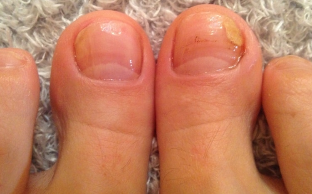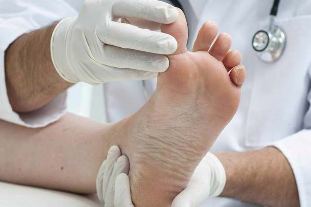Darkening of the nail plate, to its thickening, delamination, and not all of it can be a sign of the development of nail fungus (onychomycosis). Many patients confuse an infected injury, or psoriasis. In order to prevent the deterioration of the disease, you need to know how to identify fungus on toe nails, its types and symptoms.
The different types of nail fungus

Most often, the yeast infection has spread, not only on the nails and affect about the nail area. It also suffers from the skin of the feet and the interdigital folds such as the hands and the feet (athlete's foot). Among the most common pathogenic micro-organisms that cause negative changes can be distinguished:
- yeast – an instant hit on the nail, making it thinner, which leads to the delamination of the plate from the bureau for development of education;
- dermatophytes – penetrates the stratum corneum, causing the occurrence of yellow bands or patches of white, which in the end will be increased;
- mildew penetrates into the upper layers of the plate, and change the color to green, grey or black.
When the infection affects the nails, in the early stages of development, are already showing the changes, on the basis of which we can distinguish 3 main types of fungi.
- Distal onychomycosis. The player starts at the edge of the stratum corneum, and then the infection moves to the base of the plate. The nail becomes a greyish, thick, or thins, is to be demolished, and in the end, almost completely destroyed.
- Proximal fungal. It extends from the center of the plate, causing the darkening and destruction.
- Superficial onychomycosis. Associated with the occurrence of white spots in the center of the nail, or at its edges. At the beginning of the disease, the plaque there are no deformations, but is a touch noticeable looseness that ultimately lead to a shift in the bed, and the hair and the nails.
The first signs and symptoms of nail fungus
The development of the fungus there are no hidden processes. A few days after the infection in the first signs and symptoms, which in the end will become lighter.
- The nails grow dull, lose its glow and change in the pattern of the plates appear yellow or white blotches, longitudinal stripes.
- The change of the shape of the nail, is its deformation, which is accompanied by a thickening or a thinning of the stratum corneum. This state of affairs gives rise to delamination, attrition plate, and the further away from the bed.
- Experiencing pain when it is pressed. In the stratum corneum and in the surrounding tissue become inflamed.
- Diaper rash is between the toes, and the smell of the affected nail.

These signs and symptoms help to identify a nail fungus in its early stages of development, and to distinguish from other illnesses (bruises, psoriasis, eczema, lichen).
Diagnostic methods
In the case of detection of onychomycosis or the fungal infection usually goes through several stages, which include specific methods: the clinical picture, microscopy.
Initially, the expert drew attention to the symptoms and complaints of the patient, collection of clinical data. After the examination of the nail plate and the skin around them is a doctor prior to the identification of the organism and, with the exception of the other similar diseases (psoriasis, red tile, the trouble with normal, the nutrition of the nails).
The confirmation of the disease, the specialist makes the material to carry out the microscopic examination. The affected area takes a scraping of tissue in the laboratory, are treated with a special substance.
More accurately, to diagnose fungal property helps in the study of biological materials. The analysis is performed by microscopy. Sowing is done by scraping. A sample of the affected tissue, is located in the nutrients for the fungus of environment. After 3-5 days, you can get the results of the procedure. A type of fungus manages to learn the structure of the colonies, and their specific growth rate and specific color.
Thanks to all of the biological studies clearly establish the type of the virus and its sensitivity to specific antimicrobials. This allows not only the identification of the correct pathogen, but also to select the most effective treatment.
How to identify a nail fungus at home?
Darkening of the nail plate, the porosity and the depletion may not always indicate onychomycosis. To find out whether a fungal infection, you can also use the iodine and potassium permanganate.
Define onychomycosis by potassium permanganate
The procedure for the identification of fungi requires a little bit of time, and it is not easy to implement. In a basin of hot water to dissolve some of the manganese may have made a poor decision. Put liquid hand or foot, wait for 5-10 minutes. During this period, the healthy nail will be painted in a brown color, the affected areas will remain unchanged.
Identification of nail fungus with iodine
Apart from the manganese, iodine can indicate the presence of pathogens of onychomycosis. It helps to exclude other fungi, especially tinea versicolor. If the skin around the nail appears peeling, redness, you need to have these areas treated with iodine. A healthy skin it is nearly dark under the alcoholic solution, but in places on the affected areas will be a rich, dark color.
How to distinguish a fungal infection of the nails of the other diseases?
In the early stages of the development of a fungal infection may be confused with diseases of the skin (psoriasis, shingles) or trauma to the nail. You do not stand for the negative events, it is important for you to know the main differences of the fungal growth.

- Darkening of the nail plate, the appearance of yellow spots and longitudinal stripes, which eventually become larger and penetrate deeper into the nail.
- The smooth progression of the disease, no suffering and a peaceful, as is the case in psoriasis. The fungus gradually deforms the nail plate to its distance from the bed.
- The odor and the painful sensations, also distinguishes a fungus from the injury or the psoriatic lesions, eczema, lichen.
- The reasons for the emergence of fungi, it can be access in the public areas (pool, sauna), wearing tight shoes (microtrauma and away), the increased sweating of the feet, diaper rash, and is in contact with an infected person.
- The fungus was originally to be displayed on a particular screen, it is often great, and then it affects the rest of the phalanges and interdigital areas.
These distinctions help to identify the fungus at an early stage of its development. The main thing is to understand that self-diagnosis is not enough. For an effective treatment, you need an examination by a specialist.
Mycosis – a nasty and insidious disease that can masquerade as other pathologies (psoriasis, eczema). It is important that you follow take a closer look at the nails and the feet, and when the suspicious symptoms in time to see a doctor for prompt treatment.





























